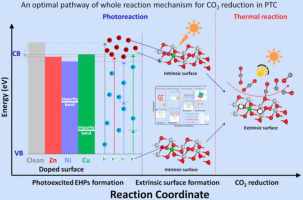Nano Energy ( IF 17.6 ) Pub Date : 2017-09-12 , DOI: 10.1016/j.nanoen.2017.09.023 Chenyu Xu , Yanwei Zhang , Fuqiang Pan , Wenhui Huang , Bowen Deng , Jianzhong Liu , Zhihua Wang , Mingjiang Ni , Kefa Cen

|
The solar photo-thermochemical cycle (PTC) for the conversion of CO2 into fuels over metal oxides is a novel and promising method to alleviate the increasing energy crisis and worsening global climate change. Density functional theory (DFT) calculations of the anatase (101) surface of TiO2 and M-doped TiO2 (M = Zn, Ni, and Cu) were performed to provide guidance for enhancing the PTC. Additionally, M-doped TiO2 films were produced using a sol-gel method and applied to the PTC for CO2 conversion to provide experimental verifications. A maximum, stable production of CO of 10.80 μmol/g was achieved using Cu-doped TiO2, which was nearly 6.39-fold higher than the amount of CO produced by clean TiO2. The CO yield was in good agreement with the calculation results. High-resolution transmission electron microscopy (HRTEM), energy-dispersive X-ray spectroscopy (EDXS), X-ray diffraction (XRD) and electron spin resonance (ESR) were used to evaluate the crystal structures and morphologies. UV–visible diffuse reflectance spectra (UV–visible DRS), photoluminescence (PL) and X-ray photoelectron spectroscopy (XPS) analyses were also conducted to investigate the surface charge-transfer and reaction mechanisms. As a result, a complete cycle reaction mechanism for Cu-doped TiO2 was proposed. Several key factors of the mechanism were clarified, and an effective guide for nanostructure design was proposed.
中文翻译:

指导用于光热化学CO 2转化的有效纳米结构设计:从DFT计算到实验验证
用于通过金属氧化物将CO 2转化为燃料的太阳光热化学循环(PTC)是一种新颖而有前途的方法,可以缓解日益加剧的能源危机和全球气候变化的恶化。进行了TiO 2和M掺杂的TiO 2(M = Zn,Ni和Cu)的锐钛矿(101)表面的密度泛函理论(DFT)计算,为增强PTC提供了指导。此外,使用溶胶-凝胶法制备了M掺杂的TiO 2膜,并将其应用于PTC进行CO 2转化以提供实验验证。使用铜掺杂的TiO 2可以最大稳定地产生10.80μmol/ g的CO,这比清洁的TiO 2产生的CO量高出将近6.39倍。一氧化碳收率与计算结果吻合良好。高分辨率透射电子显微镜(HRTEM),能量色散X射线光谱(EDXS),X射线衍射(XRD)和电子自旋共振(ESR)用于评估晶体结构和形态。还进行了紫外可见漫反射光谱(UV-DRS),光致发光(PL)和X射线光电子能谱(XPS)分析,以研究表面电荷转移和反应机理。结果,提出了Cu掺杂的TiO 2的完整循环反应机理。阐明了机理的几个关键因素,并提出了有效的纳米结构设计指南。


























 京公网安备 11010802027423号
京公网安备 11010802027423号